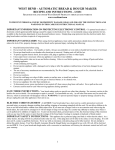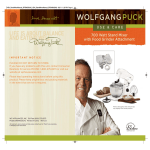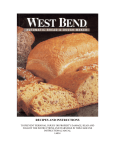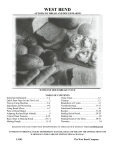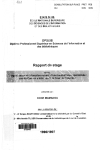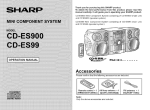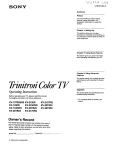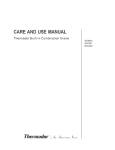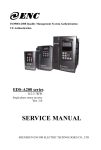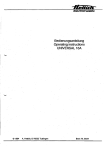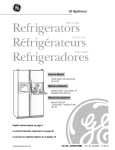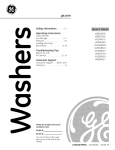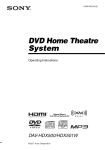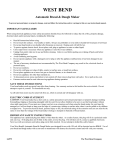Download West Bend Just For Dinner Breadmaker Specifications
Transcript
WEST BEND - AUTOMATIC RECIPES BREAD & DOUGH AND INSTRUCTIONS MAKER -L5231 REGISTER THIS AND OTHER WEST BEND@ PRODUCTS THROUGH OUR WEBSITE www.westbend.com TO PREVENT PERSONAL INJURY OR PROPERTY DAMAGE, READ AND FOLLOW THE INSTRUCTIONS WARNINGS IN THIS CARE/USE INSTRUCTIONAL MANUAL IMPORTANT INFORMATION ON PROTECTING ELECTRONIC CONTROL AND - To protect bread maker's electronic control against possible damage caused by surges in electrical power line, we recolrnnend using a surge protector device, available in the electronic department of most discount/hardware stores. Simply plug surge protector into the electrical outlet, then plug bread maker cord into receptacle of surge protector. IMPORTANT SAFEGUARDSWhen using electrical appliances, basic safety precautions should always be followed to reduce the risk of fire, property damage, electrical shock and/or personal injury, including the following: • • • • • • Read all instructions before using. Do not touch hot surthces. Use handles or knobs. Always use potholders or oven mitts to handle hot bread pan or hot bread. Do not put hand inside oven chamber after bread pan is removed. Heating unit will still be hot. To protect against electric shock, do not place cord, plug or appliance in water or other liquid. Close supervision is necessary when any appliance is used by or near children. Unplug fioln outlet when not in use and before cleaning. Allow to cool beiSre putting on or taking offparts and before cleaning appliance. Avoid contacting moving parts. Do not operate appliance with a damaged cord or plug or after the appliance malfunctions or has been damaged in any manner. The use of accessory attachments not recolnlnended by The West Bend Company may result in fire, electrical shock or personal injury. Do not use outdoors. • • • • • Do not let cord hang over edge of table, counter or surface area, or touch hot surfaces. Do not place appliance on or near a hot gas or electrical burner, or in a heated oven. Do not use appliance for other than intended use. To disconnect power, press stop button to turn control off; then remove plug tiom walt outlet. Never pull on the cord. Extreme caution must be used when moving appliance during operation. • • • SAVE THESE INSTRUCTIONS - Your bread maker needs no special care other than cleaning. See ,a_arranty section in this booklet for sela_ice details. Do not attempt to repair it yoursel£ For household use only. An offodor from motor may be noted with first use, which is normal and will disappear with use. WARNING: To prevent personal injury or property damage caused by fire, always unplug this and other appliances when not in use. ELECTRIC CORD STATEMENT - CAUTION: Your bread maker has a short cord as a safety precaution to prevent personal injury or property damage resulting fiom pulling, tripping or becoming entangled with the cord. Do not allow children to be near or use this bread maker without close adult supela_ision. If you must use a longer cord set or an extension cord when using the bread maker, the cord must be arranged so it wilt not drape or hang over the edge of a counter-top, tabletop or surface area where it can be pulled on by children or tripped over. To prevent electrical shock, personal injury or fire, the electrical rating of the extension cord you use must be the same or more than the wattage of the bread maker (wattage is stamped on backside of bread lnaker). IMPORTANT SAFETY INSTRUCTIONS - This appliance has a polarized plug (one blade is wider than the other). As a safety feature, this plug wilt fit in a polarized outlet only one ,a_ay. If the plug does not fit fully in the outlet, reverse the plug. If is still does not fit, contact a qualified electrician. Never use with an extension cord unless plug can be fully inserted. Do not attempt to defeat this safety feature. Your West Benda) Automatic Bread & Dough Maker ,a_as designed for use with 120 volt, 60 hz electrical sela_ice ONLY. Use of your bread and dough maker with a converter or transformer will destroy the electronic control and will void your warranty. "QUICK START" STEPS FOR 1. WHAT YOU WILL NEED FOR MEASURING • • • • • See-through liquid measuring cup with graduated markings Set of solid, nesting type measuring cups for dry ingredients Set of measuring spoons Kitchen spoon Table knife THE FIRST LOAF FOR MAKING Water BREAD Butter or Margarine Bread Flour Sugar Dry Milk Salt Active Dry Yeast 2. HOW TO MEASURE - Measuring ingredients the right way with the correct measuring cups and spoons is the most important step to f\_llow when making bread. See measuring section for more inforlnation. REMEMBER TO: Ahvays measure liquid ingredients in see-through measuring cup with graduated markings. Liquid should just reach marking on cup at "eye-level", not above or below. For easier measuring, set cup on inside of top kitchen cabinet. Ahvays spoon dlT ingredients, like bread flour, into solid, nesting D'pe measuring table kaaife. cups, then level off with Never scoop measuring cups into dry ingredients as this will pack down the ingredients, causing the dough to be dl3" and the loaf to be short. Ahvays use set of measuring spoons to measure smaller quantities of dry and liquid ingredients, measuring level, not rounded or heaping. 3. MAKING BASIC WHITE BREAD - 1½ LB. LOAF 9 ounces lukewarm water (1 cup + 2 tablespoons), about 75-85 ° F. 2 tablespoons butter or margarine 3 cups bread flour 1½ tablespoons sugar 1½ tablespoons dry milk 1½ teaspoons salt 2 teaspoons active dry yeast 1. Put kalead bar in pan over shaft. Twist if needed to slide do,a_ all the way. 2. Measure water and add to pan with butter. 3. Measure bread flour, sugar, dry milk and salt; add to pan. Level ingredients. 4. Make shallow welt in center of dry ingredients; add yeast.. Lock pan into machine. way to turn. See directional arrow on edge of pan for which 4. PROGRAMMING CONTROL FOR MAKING BREAD 1. Plug cord into electrical outlet. Machine is already programmed for making basic/specialD bread at the medium crust setting. Anows will point to basic/specialD and medium settings on control. 2. Press start/stop button to turn machine on. Red light will come on. Bread making process will begin. Bread will be done in 3 hours and 10 minutes. Timer will count down in minutes so you always know how much time remains until bread is done. 3. When done, alert will sound and 0:00 will appear in display. Turn machine offby holding start/stop button down until red light goes out, about 4 seconds. 4. Unlock pan and remove with hot pads. Shake loaf out and place on rack to cool 15 to 30 minutes before slicing. Wash pan following cleaning instructions in this book. KNOW YOUR INGREDIENTS Although bread making seems very basic, it is a science in which the proportions of ingredients are critical. Read the following inforlnation to better understand the importance of each ingredient in the bread making process. Also, always make sure ingredients are fresh. • FLOURisthemainingredient inmaking bread.It provides structure andfoodfortheyeast.Several different typesofflour canbeusedinyourbreadmaker, butDONOTUSEall-purpose flour,cakeflourorself-rising flouraspoorresults will be obtained. BREADFLOURSHOULD beusedinyourbreadmakerasit contains moregluten-forming proteins thanall-purpose flourandwillprovidetall,wellforlnedloaves withgoodstructure. Several different brands ofbreadflourareavailable forusein yourbreadmaker. • WHOLE WHEAT FLOUR can be used in your bread maker at the whole wheat setting. This flour contains the entire wheat kernel, including the bran and germ; therefore, breads made with 100% or a high percentage of whole wheat flour will be lower in height and heavier in texture than bread made with bread flour. The whole wheat setting on your machine has a longer knead time to better develop the structure of wheat breads for optimum results. • RYE FLOUR can be used in combination with bread flour in the preparation of rye or pumpernickel bread. But, it cannot be used alone as it does not contain enough protein to develop adequate gluten for structure. SPECIAL NOTE ON FLOUR - How to make minor adjustments for dough: All flours are affected by growing conditions, milling, storage, hmnidity and even the manufacturer. While not visibly different, you may need to make some minor adjustments when using different brands of flora as well as compensating for the humidity in your area. Always store flour in an air-tight container. Store whole grain flours (whole wheat, rye) in retiigerator to prevent them from becoming rancid. Measure the amount of flour as directed in each recipe but make any adjustment after the first 8 to 10 minutes of continuous kneading. FeelJ?ee to check the condition oflthe do_@ during the knead c;vcle as this' is the only time you can make al_v minor adjustment: • Open cover and touch dough. If it feels a little sticky and there is a slight smear under the knead bar, no adjustment is necessary. • If dough is very sticky, clinging to the sides of pan or in one comer, and is lnore like a batter than a dough, add one tablespoon flour. Allow it to work in before making any further adjustment. • If dough is dry and the machine seelns to be laboring dm-ing kneading, add one-teaspoon lukewarm water at a time. Once again, allow it to work in before making any further adjustments. • The dough is just right near the end of the kneading cycle when it is soft to the touch, smooth in appemance and just a bit sticky, leaving a slight residue on your fingers-the feel of perfect dough. The bottom of the bread pan will also be clean of any dough residue. • DO NOT EXCEED 3 cups of bread flora for the 1½ pound loaf or 2 cups bread flora t\)r the 1 pound loaf. Breads containing whole wheat, cereals or oats should not exceed a total of 3½ cups for the 1½ pound loaf or 2½ cups for the 1 pound loaf. • SUGAR AND OTHER SWEETENERS provide food for the yeast, add height and flavor to the bread and give the crest a golden color. Types of sweeteners that can be used include sugar, brown sugar, honey, molasses, maple syrup, corn syrup and fiuits, whether dried or fresh. When using a liquid sweetener such as honey or molasses, the total alnount of liquid in the recipe will need to be reduced slightly by the same measurelnent of liquid sweetener used. A special tip when measuring sticky liquid sweeteners is to coat the measuring spoon with vegetable oil before measuring. This will help the liquid sweeteners slide right out. DO NOT USE ARTIFICIAL SWEETENERS as a substitute for sugar and other natural sweeteners as the yeast will not react properly and poor results wilt be obtained. • MILK enhances flavor and increases the nutritional value of bread. Any type of milk (whole, 2%, 1%, skim, buttermilk or canned evaporated milk) can be used. Retiigerated milk must al,a_aysbe warmed to 75-85 ° F before adding to bread pan. Warm in a glass-measuring cup in microwave or in a small pan on top of the range. DO NOT HEAT MILK ABOVE 110 ° F AS THIS COULD AFFECT THE YEAST. • WATER used in combination with dry milk is a good substitute for regular milk and must be used when using the timer feature as regular milk can spoil when left at room temperature for several hours. Use luke,a_arln ,a_ater,about 75-85 ° F, for best results. DO NOT USE WATER ABOVE 110° F AS THIS COULD AFFECT THE YEAST. Using too much liquid can cause the bread to collapse during the bake needed as the flour wilt absorb moisture fiom the air. In dry weather, moisture. When you experience a severe change in weather, it is best as noted in the FLOUR paragraph for any minor adjustment that may cycle. During hmnid weather, slightly less liquid may be slightly lnore liquid may be needed as flour can lose to check the condition of the dough during the knead cycle be needed. Water and milk are mostly interchangeable in recipes. Eliminate dry milk in recipes when substituting milk for water. Check dough during the knead cycle for any minor adjustments. Slightly more milk may be needed when substituting for water. • BUTTER, MARGARINE, SHORTENING and OILS serve several purposes as they tenderize the bread, add flavor and richness and contribute to the storage life of bread by retaining moisture. An excess of fat, however, can inhibit rising, so accuracy is critical. Butter, margarine and solid shortening are interchangeable in recipes. You may wish to cut butter and margarine into four (4) pieces for faster blending during the knead cycle. Do not use reduced tat margarines as they contain more water and can affect the size of the loaf'. If substituting oil for a solid tat, reduce the amount of liquid in recipe by V2to 1 tablespoon, making aW minor adjustment during the kalead cycle to obtain the right dough consistency. Low-fat or fat-tiee bread can be made by substituting equal amounts of unsweetened applesauce or plain nonfat yogurt for the amount of tat in the recipe. Watch dough as it kaleads for any minor adjustment. • EGGS add color, richness and leavening to bread. Use large eggs. No premixing is needed. Egg substitutes can be used in place of tiesh eggs. One egg equals ¼ cup of egg substitute. To reduce cholesterol, you can substitute two (2) egg whites for each large egg in the recipes without affecting the end result. Watch the dough during the kalead cycle for any needed adjustments. A special tip when using eggs' is to run them m_der warm waterJor about one re#rote before cracking, as this helps the egg slide out of the shell better. • SALT has several functions in making bread. It inhibits the yeast mowth while strengthening the gluten structure to make the dough more elastic, plus it adds flavor. Use ordinary table salt in your bread maker. Using too little or eliminating the salt will cause the dough to over-rise. Using too much can prevent the dough tiom rising as high as it should. "Light" salt can be used as a substitute tbr ordinary table salt, providing it contains both potassium chloride and sodium. Use same amount as recmrnnended for table salt. When adding salt to pan, add to one corner to keep it awco' f_om yeast, especially when using timer as the salt can retard its'growth. • YEAST is a living organism, which, through fermentation, feeds on carbohydrates in flour and sugar to produce carbon dioxide gas that makes the bread rise. Active dry, fast rising or bread machine yeast can be used in your bread maker. Use only the amount stated in the recipe. Using a little more can cause the dough to over-rise and bake into the top of bread maker. Fast rising yeast and bread machine yeast are virtually the same and interchangeable. DO NOT USE COMPRESSED CAKE YEAST. Recipes in this book were tested using only active dry, fast rising and bread machine yeast. Keep yeast stored in the reliigerator. You may find it handy to purchase yeast in glass jars so as to measure the exact amount without having to ,a_asteany. If using yeast packed in a ¼-ounce toil envelope, it is best to open a tiesh envelope every time you bake. If you save the unused alnount from the open envelope, store in a dry, airtight container in the refrigerator. Date the container and use promptly. Do not mix old and new yeast in a recipe. A ¼-ounce foil envelope of yeast contains 2¼ teaspoons. ALWAYS MAKE SURE YEAST IS FRESH AND HAS NOT EXPIRED THE "USE BY" DATE PRINTED ON THE JAR OR ENVELOPE. VITAL WHEAT GLUTEN is the gluten protein, which has been rinsed from wheat flour and then dried. Vital gluten will increase the protein content in flour to produce a higher loaf of bread with lighter texture. About the only time you may wish to consider adding vital gluten is for 100% whole wheat bread or recipes containing a high percentage of whole wheat or other whole _ain floms or cereals. As a guideline, add one (1) teaspoon vital gluten per cup of flour used in the recipe. Check the dough during kaleading; you may need to add a little water as the vital gluten absorbs liquid. Vital gluten can be obtained at most health food stores. Do not use gluten flour, as this contains less protein and is less effective. Or, to increase the protein content, you can use a large egg as a substitute for vital gluten. Just add it to the liquid in the bottom of pan and reduce the recommended amount qfliquid in recipe by two (2) ounces (¼ clip). Again, check the condition of the dough during the kalead cycle. • CINNAMON AND GARLIC: Adding too much cinnamon or garlic can affect the texture and size of the loaf'. Cinnamon can break down the structure of the dough, affecting height and texture, and garlic can inhibit the yeast activity. Use only the amount of cinnamon and garlic recommended in the recipe; don't be generous. MEASURING INGREDIENTS: THE KEY TO SUCCESSFUL BREAD MAKING - The most important part of bread making is to MEASURE THE INGREDIENTS PRECISELY AND ACCURATELY. You may need to adjust your measuring habits, but the rewards for doing so will be great. Follow these very important tips: • READ the recipe first and organize the ingredients in the order in which they are added to the pan. Many bread disasters occur because an in_edient was left out or added twice. • DO NOT EXCEED the ingredient capacity of the bread maker. Use only fiesh ingredients. • ALWAYS ADD INGREDIENTS in the order listed: liquid ingredients first, then butter or margarine, dry ingredients next and finally yeast in the very center. Before adding yeast, ALWAYS tap the pan to settle dry ingredients into corners of pan to prevent liquid fiom seeping up. Make a slight well in center of dry ingredients and place the yeast in the well. This sequence is very important, especially when using the timer to prevent yeast fioln getting wet before bread making begins. 1. ALWAYS use standard glass or plastic "see-through" liquid measuring cups to measure liquids. See Diagram 1. Place cup on flat surface and measure at "eye level", not at an angle. The liquid level line MUST be right to the measurement marking, not above or below. A "looks close enough" measurement can spell disaster in bread making. SPECIAL TIP: Place liquid measuring cup on inside of kitchen cabinet to measure at eye level. Liquid level must be exact to markings height of the loaf on liquid measuring cups. Too lmtch or too little liqltid will q[]ect the 2. ALWAYS use standard dry measuring cups (cups that nest together) to measure dry ingredients, especially flour. ALWAYS SPOON dry ingredients into the measuring cup, then level with a kafife. DO NOT SCOOP measuring cups into dry ingredients, especially flour, as it compresses the ingredients into the cup and causes the dough to be dry and result in a short toa£ See Diagrams 2 and 3. SPECIAL TIP: To lighten flour before measuring, move a spoon through it several times. All ingredients measured in measuring si_oons mltst be level, not rounded or heaping. _i_! _ L _.Z_ 4 3. ALWAYS use standard measuring spoons for ingredients such as yeast, salt, sugar, dry milk and small amounts of honey, molasses or ,a_ater. The measurelnents MUST BE LEVEL, not rounded or heaping as a little difference can affect the bread. See Diagram 4. DO NOT USE TABLEWARE AS MEASURING SPOONS as these vary in size and will not be accurate. USING BREAD MIXES Pre-packaged bread mixes can be used in your bread maker. Follow the directions for making a 1V2pound loaf. Use the basic/specialD" bread setting for most mixes unless preparing a 100% whole wheat or natural grain mix, which would require the whole wheat bread setting. Add the recommended amount of liquid to the bread pan first, then flour mixture and finally the yeast. Select desired crust color and start. The timer feature can be used with bread mixes providing no perishable ingredients are used such as milk and eggs, which can spoil when left at room temperature for several hours. M_JAN[ R _N,'T X_NJLEN t'(HAN _ SPECIAL NOTE: If using a mix that makes a one (1) pound loaf of bread, you may wish to add additional flour and water to increase the amount of dough to better fill the pan and obtain a nicer loaf of bread. If bread mix weighs 12 ounces or less, increase the amount of water or liquid recommended I© by 1½ om_ces (3 tablespoons) and add ½ cup flour to the dry ingredients. When the dough is ka_eading, check if any minor adjustment in water or flour is needed. If mixes weigh more than 12 ounces, use as is as there will be sufficient dough to fill the pan. MAKE YOUR OWN MIXES - To save time, 1honey and energy, you an prepare your own mixes and store them in the refiigerator until ready to use. Simply measure all dry ingredients in the recipes EXCEPT YEAST into a plastic bag or sealable container. Label the type of bread and loaf size. When ready to use, let the flour mixture stand at room temperature 15 minutes. Add recommended liquids, then the dry flour mixture to pan. Level and add yeast to the center. Program and start the bread maker. Use timer if recipe recommends its use. ADAPTING YOUR FAVORITE BREAD/DOUGH RECIPES - After you have prepared some of the recipes in this book, you may wish to adapt your own conventional bread recipes. Some experimentation will be required and you wilt need to check the condition of the dough during the knead cycle for any adjustments needed. Either use one of the recipes in this book that is similar to your recipe as a guide, or use this forlnuta: For each cup of flour used in recipe use: For Example, based on the t\_rlnula to the left using 3 cups of flour start with: 3 ounces liquid, 75-85 ° F ½ tablespoon tat ½ teaspoon salt ½ tablespoon sweetener scant 3/4teaspoon active dry or ½ teaspoon bread machine/fast rise yeast 9 ounces liquid, 75-85 ° F 1½ tablespoons tat 3 cups of bread flour 1V_,teaspoons salt 1½ tablespoons sweetener 2 teaspoons active dry or 1½ teaspoons bread lnachine/fast rise yeast Add in_edients to pan in recommended sequence: liquids first, then fat, then all dry in_edients except yeast. Level dry in_edients in pan. Make a slight well and add yeast to well. Pro_aln t\_rbasic/specialty setting, medium crust color. After 10 minutes of continuous kneading, check the condition of dough. It should be soft, a bit sticky with a slight smear under the knead bar. If too wet and sticky, add one (1) tablespoon of flour at a time until dough gathers into a ball and does not cling to sides of pan. If too dry and motor is laboring, add one (1) teaspoon liquid at a time until the dough becomes lnore pliable. DO NOT EXCEED 3 CUPS OF BREAD FLOUR FOR A 1½ POUND LOAF; 2 CUPS OF FLOUR FOR A 1 (ONE) POUND LOAF. HIGH ALTITUDE ADJUSTMENT - Reduced air pressure at high altitudes causes yeast gases to expand more rapidly and the dough to rise more quickly. The dough can rise so much that when it begins to bake, it wilt collapse due to overstretching of the gluten structure. To slow the rising of the dough at high altitudes, reduce the amount of yeast by ¼ teaspoon at a time until you find the right amount. You can also reduce the amount of liquid by a teaspoon or two. Some experimentation will be needed when using your bread maker at high altitudes. Make notes on the amount of yeast and liquid used for future reference. BECOME FAMILIAR Please review it carefully Maker". WITH CONTROL PANEL to better understand each button. - The bread maker's control panel was designed to be very easy to use. Either look at the control panel on the bread maker or see "Parts of Bread BREAD SELECT BUTTON - The bread select button lets you choose the bread settings as well as the dough setting. With each press of the bread select button, the indicator arrow wilt point to a bread or dough setting on the control panel. The time required to complete each setting will also appear in the display. The bread select settings offered are: basic/specialty whole wheat dough 3:10 (medium crust) 3:40 (medium crust) 1:20 The basic/special D"bread setting can be used tbr ahnost any bread recipe containing at least 50% bread flour. Ifa recipe contains less than 50% bread flour, then use the whole wheat setting as this features a longer knead cycle which is beneficial for whole _ain flour, such as whole wheat. See "Basic Steps in Making Bread". The dough setting prepares dough t\_rhand shaping and baking in your own oven. When using the basic/specialD, whole wheat and dough settings, an audible alert will sound during the knead cycle as a reminder add in_edients, such as nuts or raisins, if recmrnnended in recipe. If not adding extra ingredients, iguore this alert or use it as a checkpoint to check the condition of the dough for any needed adjustlnent. See "Special Notes on Flour". to CRUST COLOR BUTTON - The crust color button lets you choose three (3) different crust colors tbr breads made at basic/specialty and whole wheat settings. With each press of the button, the indicator arrow will point to light, medium or dark on the control panel. The crust color button does not apply to the dough setting. TIMER BUTTONS - The timer lets you program the bread maker to start at a later time, which is convenient if you wish to wake to a fresh loaf of bread in the morning or come home to a fresh loaf for dinner. The timer can be pro_alnlned to delay the start of the bread maker for up to 13 hours. When using the timer feature, no perishable ingredients should be used, such as milk, eggs, cheese, yogurt, etc., as these foods can spoil when held at room temperature for several hours. Use timer only with recipes with the @ symbol as these do not contain any perishable ingredients. 6 1.Followsteps1-4formaking breadonpage9 ordough onpage19.Countthenumber ofhoursandminutes between thetimeyou will startthemachine to,ahen youwantthebreadordough tobedone.Forexample: Youarereadytostartthemachine at9:30andwantthebreaddoneat6:00.Thenumber ofhoursandminutes between 9:30and6:00is 8'/_, hoursor8:30.8:30isthetimeyouenterintothetimer.Press andholdthe(up) timerbuttontoscrollthetimeupin 10minuteincrements until8:30appears indisplay.If yougopast8:30, usethe(do,a_)T timerbuttontoscrolldownin 10minuteincrements untilyoureach8:30.Themaxilnum timefortimeris 13hours(13:00).Thebreadordough process timeisautomatically figuredintothedelaytime asthisis thetimefiomwhichyoubegintocountup. 2. Press start/stop button once to turn machine on. The red light wilt glow, colon between hour and minutes will flash and timer will begin counting down in minutes. When timer reaches the programmed bread or dough process time, the machine will begin making bread or dough. When done, 0:00 will appear in display and audible alert will sound that it is done. If in bread mode, the machine will automatically go into keep warm cycle for up to three horns or until the machine is turned oft'. If in the dough mode, the machine will automatically turn itself off when the dough is done. Unplug Relnove bread or dough from machine. Always use oven mitts when removing hot bread fiom bread on rack 15 to 30 minutes before slicing. CAUTION: To prevent personal injury, do not touch cover, vent or sidewalls of bread maker during are hot. Do not put hands inside oven chamber or touch the heating unit after completion of the bake hot. cord from electrical outlet. maker after baking. Cool loaf the bake cycle, as these surfaces cycle, as these surfaces are also START/STOPORON/OFFBUTTON- (Wording for this button varies with model.) Use the start/stop button to turn bread maker on and oft'. Before starting the machine, you must first progranl the bread select and crust color, plus the timer if being used. Press start/stop button once to turn machine on. When on, red signal light by button will glow and remain lit until bread maker is turned off. To turn oft; press and hold start/stop button down for about four (4) seconds or until light goes out. When the machine is on, the colon between hours and nlinutes will flash and minutes will begin to count down the time remaining until bread is done. When process time elapses, 0:00 will appear in display and audible alert will sound. Turn offby pressing start/stop button until red light goes out. Remove bread pan using oven mitts and shake loaf out of pan onto cooling rack. Cool before slicing. If pan is not removed ilrnnediately after baking, machine will automatically go into keep warnl mode for up to three (3) hours to keep bread warm. The red light will relnain lit during this time and 0:00 will appear in display. Ifnlachine is not turned offduring keep warm period, machine will automatically turn off. If using dough setting, machine will automatically turn offupon completion of cycle, alert will sound and display wilt reset to dough setting. Remove dough and finish as recommended in recipe being prepared. Do not leave pan-containing dough inside machine after completion of cycle as dough will continue to rise and could overflow the pan. See Dough section on page 19 t\_r more detail. TOO HOT/TOO COLD WARNINGIf inside of oven chanlber is too hot or too cold for bread making, the word "hot" or "col" will appear in display along with alert sounding to indicate that machine cannot be turned on. You will need to relnove pan and allow chamber to cool or warm accordingly. Typically "hot" will appear in display when you make consecutive loaves and forget to turn machine offbetween loaves. Allow chanlber to cool with cover open 10 to 15 minutes or until nlachine can be turned on without warning going oft_ If"col" appears in display, move bread maker to a warmer area for 15 minutes or until nlachine can be turned on without warning going ofl_ If oven is too hot, the yeast can be killed; if too cold, the growth of the yeast will be retarded. POWER OUTAGE PROTECTION - In the event of a power outage, the bread maker will turn offand autonlatically resume the cycle in progress if power is restored within 5 to 10 seconds, If power is not restored in 5 to 10 seconds it will remain offwhen power is restored. In this case, you must remove the contents from pan and start over with fiesh ingredients. The red on light will remain off and the display will reset to the default setting; basic/specialty, medium crust, with 3:10 in display. BASIC STEPS IN MAKING BREAD - BEFORE USING your bread maker for the first time, wash inside of pan and knead bar with hot soapy water and a soft cloth, rinse and dry. Twist pan clockwise to unlock from bread maker, then lift out. The knead bar lifts off shaft in bottom of pan. You may need to twist the bar slightly to relnove. Place knead bar onto shaft in pan, nlatching hub shape with shaft shape. Push bar down all the way. Do not use any abrasive scouring pads or cleansers on pan or knead bar as danlage can occur. Wipe the inside of chanlber and outside surfaces of nlachine with a soft damp cloth if necessary, dry with a soft cloth. CAUTION: To prevent personal injury or electric shock, do not immerse bread maker base, its cord or plug in water or other liquid. SPECIAL NOTE: Bread pan is not inllnersible and should never be washed in an automatic dishwasher. Ilnnlersing pan in water can cause damage to the bearing that turns the knead bar. Dishwasher cleaning can reduce the non-stick qualities of the coating, causing sticking of the bread. 1. Position knead bar onto shaft in bottom of pan, matching hub shape to shaft shape. See Diagram 6. Make sure knead bar is pushed onto shaft all the way. You may need to twist bar slightly to drop into place. 2. Add ingredients to pan in order listed in recipe, MAKING SURE to add all liquids to pan first, then butter or margarine, tbllowed by dry ingredients. See Diagrams 7-9. Add liquid ingredients to pan first. Then add butter or lnargarine, cut into pieces for taster blending. Diagranl 7 Diagram 8 Add dry ingredients next. Level in pan. Diagranl 9 Make a well in enter of dry ingredients and add yeast to well. Afterdryingredients areadded topan,tappantosettleingredients, thenlevel,pushing some ofthedrymixtureintocorners ofpan. Thiswill prevent liquidfromseeping upfromthecorners. Makeaslightwellincenter ofdryingredients andaddtheyeasttothe well.Thissequence ofingredients isespecially inlportant whenusingthetimertoprevent theyeastfionlgetting wetbefore bread making begins. 3.Lockpanintobreadmaker bytwisting counterclockwise. Seedirectional arrowonedgeofpanforwhichwaytoram.See Diagram 10.If pandoes notlocksecurely, relnove panandreposition untilsecured. Panmustalways belockedinplaceforbread maker tofunction properly.Closecover. Diagranl 10 4.Plugcordintoa 120voltACelectrical outletONLY.Press breadselectbuttonfortypeofbread being made. Thenpresscrustcolorbuttonfordesired color.Thetotaltimefortheselections will appear in display. Progranl timerif desired. Seepages 7-9forinstruction. g.Press start/stop buttononcetoturnonmachine. Whenon,redlightwill glowandcolonbetween hours andnlinutes will flash.Oncebreadmaker hasbeenturned onprogranlnled settings cannot bechanged. To change setting, holdstart/stop buttondownuntilredlightgoesout.Thenreprogranl controlandturnbackon.Thebreadmaking process wiltthenbegin.Faintclickingsounds indicate gentleheatbeingprovided to,a_arnl thechamber. Duringtheknead cycle,an alertwill siNmltoaddextraingredients if thereciperecommends. Opencoverandaddingredients tothepanontopofdough.These ingredients will bemixedduringtheremainder ofthekalead cycle.DONOTSTOPMACHINETOADDINGREDIENTS. If no ingredients aretobeadded, iNlorealertoruseit tocheckthecondition ofdough.See"Special NotesonFlour"onpage3. CAUTION:Toprevent personal injuryDONOTREMOVEthebreadpanortouchanymovingpartswhenbread makerisin operation. If youneedtostopthebreadmakerduringoperation, holdthestart/stop buttondownforf\3ur(4)seconds oruntilthered lightgoes out. CAUTION:Toprevent personal injury,donottouchcover,window, ventorside,a_alls ofbreadmakerduringthebakecycleasthese surfaces arehot. 6.Whencyclecompletes, 0:00will appear indisplayandaudible alertwill sound.Turnbreadmaker offbypressing start/stop until lightgoesout.Melnorywillrecallthelastprogram indisplay.Unplug cordfionlelectrical outlet. It isbesttorenlove breadinllnediately fiolnmachine f\3ra crispier crust.Opencoverandremove breadpanusingovenmitts.To unlockpan,twistclockwise, thenrelnove panfionlmachine. Handle breadpancarefully asit ishot.SeeDiagranl11. Diagranl 11 Twist pan clockwise to relnove. CAUTION: To prevent personal injury, always use oven mitts to relnove the hot bread pan from bread maker and when relnoving the baked loaf of bread fronl pan. Invert bread pan and shake until loaf falls out on cooling rack. Knead bar should stay in place when bread is removed, but may slide out with bread. If bar is inside loaf; relnove before slicing. Cool bread for at least 15 to 30 minutes. If bread is not removed when cycle completes, the bread maker will automatically go into keep warm for up to three (3) hours. The on light will remain lit and 0:00 will appear in display. When relnoving bread pan, al,a_aysuse oven mitts, as pan is still hot. Hold start/stop button down until on light goes out to turn bread maker off. Unplug cord fionl electrical outlet. If bread maker is not turned offduring keep warm, it will automatically shut offafter three (3) horns. CAUTION: To prevent personal injury, do not put hands inside oven chamber or touch heating unit after completion of the bake cycle, as these surfaces are hot. SLICING BREAD - Allow bread to cool 15 to 30 nlinutes before slicing. If you slice bread ilrnnediately after baking, it will be sticky and very difficult to slice. STORING BREAD - Since honlelnade bread contains no preselwatives, it does not stay as fiesh for as long as commercially made bread. Store bread in a plastic bag or sealed container to keep it fronl drying out. Keep bread at room temperature or in retiigerator for up to one week. For longer storage, put bread in freezer. Slice bet\3re fieezing so slices can be relnoved when needed. CLEAN AFTER EACH USE DO NOT IMMERSE BOTTOM OF BREAD PAN" IN"WATER! The bread pan is not inllnersibte and should never be washed in an automatic dishwasher. This can cause damage to the bearing that turns the knead bar and reduce the non-stick qualities of the coating, causing the bread to stick. 9 l. 2. Unplug cord fiom electrical outlet and allow bread maker to cool before cleaning. The bread pan and kalead bar must be cleaned after each use to ensure perforlnance. After bread is relnoved from pan, fill pan half full with warm water and small amount of dish soap. Set pan in empty sink or on hot pad and allow to soak for 5 to 10 minutes or until kalead bar can be lifted off shaft. Twist bar slightly to loosen. The kalead bar must soak in water before it can be relnoved. Wash inside of pan and knead bar with a soft cloth, rinse and dry. Replace bar on shaft. Be sure that shaft in pan is kept clean so that kalead bar fits properly. DO NOT use any type of utensil or tool to clean the gasket around the shaft as damage will occur and result in leakage. DO NOT use any abrasive scouring pads or cleansers on bread pan or kalead bar as damage to finish can occur. The coating inside of bread pan may change color over time, which is normal and does not affect the bread or dough. CAUTION: To prevent personal injury or electric shock, do not immerse bread maker base, its cord or plug in water or other liquid. 3. Wipe inside of chamber and outside surthces of bread maker with a damp cloth if necessary. The cover is relnovable for cleaning if needed. Simply open it 45 degrees and pull toward you. Wipe cover with a damp, soapy cloth and dry. DO NOT immerse cover in water or place in automatic dish,a_asher as water will get in between the parts and cause damage. Replace cover by aligning attachment hooks into hinge on back of bread maker. Cover should move fieely up and do,a_ after being replaced. See "Parts of Bread Maker". OTHER HELPFUL TIPS FOR USING YOUR BREADMAKER 1. BE SURE to allow adequate ventilation around the bread maker when it is in operation. Keep it out of drafts and direct sunlight and at least tour (4) inches away from walls, cabinets and other appliances, especially heating and cooling appliances which interfere with the internal bread maker temperatures and affect the loaf of bread being prepared. 2. ALWAYS place bread maker on a DRY, STABLE heat-proof countertop or table during use. Since the bread maker contains a motor, some vibration occurs during the kalead cycle. 3. DO NOT cover bread maker with anything during operation as this can cause malfunction. 4. DO NOT TOUCH control panel buttons after bread maker has been turned on as this can interrupt the cycle. Turn bread maker off after completion of cycle. 5. DO NOT LEAVE bread maker plugged into electrical outlet when not in use to prevent it fiom being accidentally turned on. BREAKDOWN OF BREAD/DOUGH CYCLES - To help you understand the bread making process, the following chart breaks down each cycle's time in minutes and seconds. These times are approxilnate and should be used only as a guide. The total process time is given in hours and minutes, depending on the crust selection made. BREAKDOWN OF BREAD /DOUGH CYCLES MIX REST KNEAD BASIC/SPECIALTY WHOLE WHEAT DOUGH 5 min. 15 min. 20 min. 5 min. 15 min. 30 min. 5 rain. 0 min. 20 min. RISE (1) 34 min. 50 min. 55 min. STIR-DOWN (1) RISE (2) STIR-DOWN (2) RISE (3) BAKE (LIGHT) (MEDIUM) (DARK) 16 sec. 15 min. 16 sec. 50 min. 40 min. 50 min. 60 min. 16 sec. 14 min. 16 sec. 55 min. 40 rain. 50 rain. 60 min. 16 sec. Total Time (Hour- 1:20 Minutes) (LIGHT) (MEDIUM) (DARK) REGULAR MIX 3:00 3:10 3:20 3:30 3:40 3:50 BREAD AND DOUGH CYCLES When turned on, the bread maker mixes ingredients about 5 minutes. The knead bar will start and stop during mixing. Rest The dough is allowed to rest about 15 minutes bel\3re kaleading, fhint clicking sounds indicate the bread maker is keeping the dough warm. 10 KNEAD Knead time varies by setting: basic/special D is 20 minutes; whole wheat is 30 minutes wheat requires the longest kalead time to better develop the gluten in whole-wheat flour. and dough is 20 minutes. Whole SPECIAL NOTE: An audible alert will sound during the knead cycle to siNlal when to add special in m'edients such as raisins or nuts, if called for. Adding these ingredients at the alert prevents them fiom becoming over mixed or crushed. If these ingredients are not required, iNlore this alert. The audible alert during the kalead cycle can be used as a reminder to check the dough for any needed adjustment. See "Special Notes n Flour" on page 3. RISE (1) The dough is allowed to rise. Faint clicking sounds indicate gentle heat being provided to keep the chamber warm. STIR-DOWN (1) Next, the dough is stirred do,a_ by the kalead bar to relnove excess carbon dioxide gas created by the yeast. SPECIAL NOTE: If using dough setting, an audible alert will sound and bread maker will turn oft; as the cycle is complete. The dough is ready for hand shaping, rising and baking in your o,a_ oven. RISE (2) - The dough is allowed to rise again, but for a shorter period of time. STIR-DOWN (2) - The dough is again stirred down by the kalead bar to relnove excess gas and to shape for the final rise. This final stir-down ensures that the bread will have good texture. RISE (3) - A final rise helps the dough achieve lnaximum height. Faint clicking sounds indicate gentle heat being provided to keep the chamber warm. BAKE - Bake time varies by crust color. An audible alert indicates turned ofl; it automatically goes into keep warm for up to 3 hours. bread is done and 0:00 appears TROUBLESHOOTING PROBLEM POSSIBLE CAUSE 3. Top inflated, mushroom-like in appearance. 4. Top and sides cave in is not GUIDE SIZE AND SHAPE - Wheat breads wilt be shorter due to less glutenforlning protein in whole wheat flour. - Not enough liquid - Sugar omitted or not enough added. - Wrong type of flour used. - Not enough yeast used or too old. - Wrong type of yeast used. 2. Flat loaves, no rising If bread maker SOLUTION LOAF 1. Short loaves. On average, 1 lb. loaves will be 4 inches high; 1½ lb. loaves 5 to 6 inches high at regular bread settings. in display. -Yeast omitted. -Yeast too old. -Liquid too hot. -Too much salt added. -Sugar or other sweetener omitted. -If using timer, yeast got wet before bread making process started. -Too much yeast. -Too much sugar. -Too much flour. -Substituted active dry yeast for bread machine/fastrising yeast. -Not enough salt. -Warm, humid weather. -May be caused by high altitude. -Too much liquid. -Too much yeast. 11 - Normal situation, no solution. - Increase liquid by 1 tablespoon. - Add in medients as listed in recipe. - Do not use all-purpose flour. - Measure amount recommended and check fieshness date on package. - Use correct type of yeast, especially important for bread machine/fiast-rising yeasts. -Add ingredients as listed in recipe -Check expiration date. -Use lukewarm liquid, about 75-85 ° F. -Use amount recommended. -Add in_edients as listed in recipe. -Push dry in_edients into corners of pan. -Make well in center for yeast. -Reduce yeast by ¼ to ½ teaspoon. -Reduce sugar by 1 teaspoon. -Reduce flour by 2 to 3 tablespoons. -Use correct amount of bread machine/fastrising yeast. -Use amount recomlnended in recipe. -Reduce liquid by 1 tablespoon and reduce yeast by ¼ to ½ teaspoon. -See "High Altitude" section on pg. 7 -Reduce liquid by 1 tablespoon. -Use alnount recolnlnended in recipe. 5.Gnarly,knotted top, notsmooth. -Notenough liquid. -Toomuchflour. -Topsmaynotallbeperfectly shaped, butwiltnot affectflavor. 6.Collapsed while baking. -Maybecaused byhighaltitude. -Exceeding capacity ofbreadpan. -Notenough saltusedoromitted. -Toomuchyeastor,aTong typeused. -Warm, hmnidweather. 7.Loafuneven. -Dough toodryandnotallowed toriseevenly in pan. BREADTEXTURE 8.HeaxT, dense texture. -Toomuchflour. -Notenough yeast. -Notenough sugar. 9.Open,coarse, holey -Saltomitted. texture. -Toomuchyeast. -Toomuchliquid. 10.Center ofloafis -Too much liquid. raw,notbakedthrough. -Power outage during -Increase liquid by 1 tablespoon. -Measure accurately. Seepg.5. -Measure recomlnended amount. -Measure accurately. Seepg.5 -Addingredients aslistedinrecipe. -Measure recomlnended amount. -Reduce liquidby 1tablespoon. -Reduce liquid by 1 tablespoon. -Bread maker will turn off automatically if power not restored within 10 seconds. You must relnove the unbaked loaf and start over with fiesh ingredients. -Always put knead bar on shaft in pan before adding ingredients. -Let cool on rack 15 to 30 minutes. -Use a good bread knife or electric knife. operation. -Forgot to put knead bar in pan. 11. Doesn't slice well, very sticky. -Increase liquidby1tablespoon. -Measure flouraccurately, levelingoff measuring cup.Seepg.5. -Having doughatpropercondition iskeyto perfect loaves. Seepg.3. -See"HighAltitude"section onpg.6. -Donotusemoreingredients than recommended forIV_, poundloa_ -Useamount recommended inrecipe. -Measure righttypeofyeastaccurately. -Reduce liquidby 1tablespoon andreduce yeastby¼to V_,teaspoon. -Sliced while too hot. -Not using proper knife. CRUST COLOR THICKNESS AND 12. Dark crest color/too thick, -DARK crest setting used. -Use LIGHT or MEDIUM crest color setting the next time. 13. Loaf is burned. -Bread maker malfunctioning. -See Warranty section for servicing. 14. Crust too light. 15. Knead bar cannot be removed, -Bread not baked long enough. -Water must be added to bread pan tbr knead bar to soak before it can be relnoved, -Use darker crust color setting. -Follow cleaning instructions after use. You may need to twist bar slightly after soaking to loosen. PAN PROBLEMS 16.Bread sticks to pan/difficult to shake -Can happen over prolonged use. -Wipe inside of bread pan, from ribs down, lightly with vegetable oil or solid shortening. Or, add 1 teaspoon vegetable oil to liquid in pan before adding dry ingredients. Do not use a vegetable spray as sticking can worsen. Or, let bread sit in pan 10 minutes before shaking out. out. -Replacement pan may be ordered. See Warranty section. MACHINE 17. Ingredients not mixed, MECHANICS -Did not start bread maker. -After programlning control panel, press start/stop button. -Knead bar must be on shaft in bottom of pan belbre adding ingredients. -Forgot to put knead bar in pan. 12 18.Burning odornoted -Ingredients spilledinsideoven. duringoperation. -Becareful nottospillwhenadding topan. Inm'edients canbumontoheating unitandcause smoke. -Replacement panmaybeordered. -Donotusemorein_edients thanrecolrnnended in recipeandalways measure accurately. Seepage5. -Panleaks. -Exceeding capacity ofbreadpan. 19.WHOOPS! Machine unplugged by mistake orpowerwas lost. -Machine haspoweroutage protection forupto 10seconds. If powernotrestored within10seconds, thenfollowmlidelines belowforcycleinpro_ess whenpowerwaslost. -If machine inkneadcycle,repro_aln tosame breadsetting andcolorandturnmachine backon. -If machine inrisecycle,remove doughfrompan,shape andplacein _eased 9-by-5-inch loafpan, coverandallowtoriseuntildoubled. Bakeinpreheated conventional ovenat350°Ffor40to45 minutes oruntilgolden brown. -If inbakecycle,preheat conventional ovento350°Fandrelnove toprack.Carefully remove pan frommachine andplaceonbottomovenrack.Bakeuntilgolden brown. HowcanI save the bread? NUTRITIONAL INFORMATION - Nutritional information was calculated using butter and whole milk when called for in the recipes and is based on a ½-inch thick slice of bread. For less calories and total tat, you may substitute margarine for butter and low-fat milk for whole milk. 100% Whole Wheat Bread Total Calories: Honey Oatmeal Bread Total Calories: 127.5 Total Fat(g):2.0 Total Carb(g):23.5 Total 134.1 Total Fat(g):2.0 Total Carb(g):24.7 Total Protein(g):4.6 Fiber(g):3.4 Chol(mg):3.8 Protein(g):4.5 Fiber(g): 1.0 Chol(mg):3.8 Sodium(mg):202.4 Sodium(mg): 199.7 50% Whole Wheat Bread Total Calories: 126.5 Total Fat(g): 1.9 Total Carb(g):23.3 Protein(g):4.3 Fiber(g):2.0 Chol(mg):3.8 Sodium(mg):200.9 Basic Dinner Rolls/Bread Italian Total Sticks Total Calories: Herb Bread Total Calories: 137.3 Total Fat(g):2.3 Total Carb(g):24.3 Total Protein(g):4.9 Fiber(g): 1.1 Chol(mg):4.4 Sodium(mg):213.7 Old Fashioned White Bread Total Calories: 115.5 Total Fat(g):2.5 Total Carb(g): 19.8 Total Protein(g):3.7 Fiber(g):0.7 Chol(mg):5.7 Sodium(mg): 146.8 Total Fat(g):2.7 Total Carb(g):25.0 Total Protein(g):5.0 Fiber(g):0.9 Chol(mg):6.7 Sodium(mg):205.6 Basic White Raisin Bread Total Calories: Bread Total Calories: 133.5 Total Fat(g):l.9 Total Carb(g):24.5 Protein(g):4.5 Fiber(g):0.9 Chol(mg):3.8 Sodium(mg): 199.9 Cinnamon Rolls Total Calories: Total Wheat Bread Total Calories: 133.0 Total Fat(g): 1.7 Total Carb(g):25.3 Protein(g):4.4 Fiber(g): 1.9 Chol(mg):2.8 Sodium(mg):297.8 Total 177.4 Total Fat(g):3.4 Total Carb(g):32.7 Total Protein(g):5.1 Fiber(g): 1.4 Chol(mg):3.8 Sodium(mg):231.3 Traditional 177.3 Total Fat(g):7.9 Total Carb(g):22.8 Protein(g):5.5 Fiber(g):0.9 Chol(mg):28.6 Sodium(mg): 126.2 Cracked Total 143.9 French Bread Total Calories: 107.3 Total Fat(g): 1.2 Total Carb(g):20.2 Total Protein(g): 3.6 Fiber(g):0.8 Chol(mg): 1.8 Sodium(mg): 158.1 Traditional Pizza Dough Total Calories: Total Fat(g): 1.9 Total Carb(g): 10.7 Total Protein(g): 1.5 Fiber(g):0.5 Chol(mg):0.1 S odium(mg): 108.8 65.7 French Bread Total Calories: 131.0 Total Fat(g): 1.6 Total Carb(g):24.5 Total Protein(g):4.3 Fiber(g):0.9 Chot(mg):2.8 Sodium(lng): 191.7 Wheat Dinner Rolls Total Calories: 105.3 Total Fat(g):2.5 Total Cmb(g): 18.1 Total Protein(g):3.7 Fiber(g): 1.6 Chol(mg):5.7 Sodium(mg): 147.3 Garlic Whole Wheat Pizza Dough Total Calories: 64.6 Total Fat(g): 1.1 Total Cmb(g): 11.5 Total Protein(g):2.3 Fiber(g): 1.9 Chol(mg):0 Sodium(mg):61.9 13 Bread Total Calories: 133.1 Total Fat(g):2.2 Total Carb(g):24.3 Protein(g):4.6 Fiber(g):0.9 Chot(mg):3.8 Sodium(lng):200.2 Total RECIPES RAISIN 1 Pound BREAD _i_ _ Basic/specialD_ Loaf 6V_-ounces (3/4cup + 1 tbsp.) 1 tablespoon 2 cups 1 tablespoon 1 tablespoon 1 teaspoon ½ teaspoon 1½ teaspoons or 1 teaspoon ½ cup % cup INGREDIENTS I_ Pound WATER, 75-85 ° F BUTTER or MARGARINE BREAD FLOUR DRY MILK SUGAR SALT GROUND CINNAMON ACTIVE DRY YEAST -ORBREAD MACHINE/FAST RISE YEAST RAISINS*** CHOPPED NUTS, optional 9½ ounces (1 cup + 3 tbsp.) 2 tablespoons 3 cups 1½ tablespoons 1½ tablespoons 1g_,teaspoons 1 teaspoon 2 teaspoons - or1½ teaspoons 3Acup ¼ cup Loaf Add in_edients to bread pan in order listed, making well in center of dry in_edients for yeast. Program for basic/specialty bread setting, desired crust color and timer, if being used. Turn on. Add raisins and nuts when alert sounds. When done, turn of! unlock pan and relnove with oven mitts. Shake bread out and allow to coot on rack before slicing. **SPECIAL TIP**: To make raisin bread overnight or without being present to add raisins and nuts, place around outside of edge of pan on top of dry in_edients away fiom yeast and not in contact with water in pan. OLD basic/specialD FASHIONED WHITE BREAD 6 ounces (3Acup) 1 tablespoon 2 cups 1 tablespoon 1 teaspoon 1½ teaspoons MILK 75-85 ° F BUTTER or MARGARINE BREAD FLOUR SUGAR SALT ACTIVE DRY YEAST 9 ounces (1 cup + 2 tbsp.) 2 tablespoons 3 cups 1V2tablespoons 1½ teaspoons 2 teaspoons -or- -or- -or- BREAD MACHINE/FAST RISE YEAST 1 teaspoon 1V2teaspoons Add ingredients to bread pan in order listed, making well in center of dry ingredients for yeast. Program for basic/special D"bread setting, desired crust color. Turn on. When done, turn oft; unlock pan and remove with oven mitts. Shake bread out and allow to cool on rack before slicing. basic/specialty HONEY 1 Pound Loaf OATMEAL BREAD ¢_) ..... INGREDIENTS 1½ Pound Loaf 5½ ounces (V3cup) 2 tablespoons 1 tablespoon 1½ cups _/_cup 1 tablespoon 3Ateaspoon 1½ teaspoons MILK 75-85 ° F HONEY BUTTER or MARGARINE BREAD FLOUR OATS, quick or old-fashioned DRY MILK SALT ACTIVE DRY YEAST 7½ ounces (_Acup + 3 tbsp.) 3 tablespoons 2 tablespoons 2 cups 1 cup 2 tablespoons 1¼ teaspoons 2 teaspoons -or- -or- -or- 1 teaspoon BREAD MACHINE/FAST RISE YEAST 1½ teaspoons Add ingredients to bread pan in order listed, making well in center of dry ingredients for yeast. Program for basic/specialty bread setting, desired crust color and timer, if being used. Turn on. When done, turn oft; unlock pan and relnove with oven mitts. Shake bread out and allow to cool on rack before slicing. 14 basic/specialD _ 1 Pound Loaf 6 ounces (3/4cup) 1 tablespoon 2 cups 1 tablespoon 1 teaspoon 2 teaspoons V2- 1 teaspoon 1V2teaspoons GARLIC BREAD _? INGREDIENTS WATER 75-85 ° F BUTTER or MARGARINE BREAD FLOUR SUGAR SALT DRIED PARSLEY FLAKES GARLIC POWDER ACTIVE DRY YEAST -or- 9 ounces (1 cup + 2 tbsp.) 2 tablespoons 3 cups 1V_,tablespoons 1V_,teaspoons 1 tablespoon 3/4- 1 teaspoon 2 teaspoons -or- -or- 1 teaspoon 1½ Pound Loaf BREAD MACHINE/FAST RISE YEAST 1V_,teaspoons Add ingredients to bread pan in order listed, making well in center of dry ingredients for yeast. Program for basic/special D"bread setting, desired crust color and timer, if being used. Turn on. When done, turn oft; unlock pan and relnove with oven mitts. Shake bread out and allow to cool on rack before slicing. basic/special_ _ 1 Pound Loaf 7 ounces (3/4cup + 2 tbsp.) 1 tablespoon 2V2cups 1 teaspoon 3/4teaspoon 1 teaspoon -or- FRENCH BREAD@ INGREDIENTS WATER 75-85 ° F BUTTER or MARGARINE BREAD FLOUR SUGAR SALT ACTIVE DRY YEAST 1 ½ Pound Loaf 9V2ounces (1 cup + 3 tbsp.) 1 tablespoon 3 V2cups 1g_,teaspoons 1¼ teaspoons 2 teaspoons -or- -or- BREAD MACHINE/FAST RISE YEAST 3/4teaspoon 11/_,teaspoons Add ingredients to bread pan in order listed, making well in center of dry ingredients tbr yeast. Program for basic/special D"bread setting, desired crust color and timer, if being used. For thicker, chewier crest, use medium or dark crust setting. Turn on. When done, turn oft; unlock pan and relnove with oven mitts. Shake bread out and allow to cool on rack before slicing. basic/special D" 1 Pound Loaf 6 ounces (3/4cup) 1 tablespoon 2 cups 1 tablespoon 1 tablespoon 1 tablespoon 1V_,teaspoons 1 teaspoon 1¼ teaspoons -OI"- INGREDIENTS WATER 75-85 ° F BUTTER or MARGARINE BREAD FLOUR GRATED PARMESAN CHEESE DRY MILK SUGAR ITALIAN SEASONING SALT ACTIVE DRY YEAST -or- 1 ½ Pound Loaf 9 ounces (1 cup + 2 tbsp.) 2 tablespoons 3 cups 3 tablespoons 1 tablespoon 1 tablespoon 2 teaspoons 1V_,teaspoons 2 teaspoons -OI"- BREAD MACHINE/FAST RISE YEAST 3/4teaspoon 1V_,teaspoons Add ingredients to bread pan in order listed, making well in center of dry ingredients for yeast. Program for basic/specialty bread setting, desired crust color and timer, if being used. For thicker, chewier crust, use medium or dark crust setting. Turn on. When done, turn oft; unlock pan and relnove with oven mitts. Shake bread out and allow to coot on rack be*\_re slicing. 15 whole wheat 1 Pound Loaf 6 ounces (3/4 cup) 1 tablespoon 1 tablespoon 1 tablespoon 2 <3cups 1 tablespoon 1 teaspoon 1½ teaspoons 100% WHOLE BREAD INGREDIENTS d,, 1½ Pound Loaf WATER, 75-85 ° F MOLASSES HONEY BUTTER or MARGARINE WHOLE WHEAT FLOUR DRY MILK SALT ACTIVE DRY YEAST -or- 1 teaspoon WHEAT 9 ounces (1 cup + 2 tbsp.) 1 tablespoon 2 tablespoons 2 tablespoons 31/_,cups 2 tablespoons 1½ teaspoons 2 teaspoons -or- -or- BREAD MACHINE/FAST RISE YEAST 1½ teaspoons Add ingredients to bread pan in order listed, making well in center of dry ingredients for yeast. Program for whole wheat bread setting and desired crust color and timer, if being used. Turn on. When done, turn oft; unlock pan and remove with oven mitts. Shake bread out and allow to cool on rack bel\_re slicing. whole wheat 1 Pound Loaf 6 ounces (3/4cup) 1 tablespoon 1 tablespoon 1 cup 1 cup 1 tablespoon 1 tablespoon 1 teaspoon 1½ teaspoons 50 % WHOLE WHEAT BREAD INGREDIENTS 1½ Pound Loaf Milk, 75-85 ° F HONEY BUTTER or MARGARINE BREAD FLOUR WHOLE WHEAT FLOUR BROWN SUGAR, packed DRY MILK SALT ACTIVE DRY YEAST - or- ii'_ 8V_,ounces (1 cup + 1 tbsp.) 1 tablespoon 2 tablespoons IV_,cups 1V_.cups 1½ tablespoons 1½ tablespoons 1½ teaspoons 2 teaspoons - or -or- BREAD MACHINE/RAST RISE YEAST 1 teaspoon 1½ teaspoons Add ingredients to bread pan in order listed, making well in center of dry ingredients for yeast. Program for whole wheat bread setting and desired crust color and timer, if being used. Turn on. When done, turn oft; unlock pan and relnove with oven mitts. Shake bread out and allow to cool on rack be*\_re slicing. whole wheat 1 Pound Loaf 6 ounces (3/4cup) 2 teaspoons 1¼ cups 2/3cups 1/3cup 1½ tablespoons 3Ateaspoon 1½ teaspoons - or CRACKED WHEAT BREAD'_ INGREDIENTS WATER, 75-85 ° F BUTTER or MARGARINE BREAD FLOUR WHOLE WHEAT FLOUR CRACKED WHEAT CEREAL BROWN SUGAR, packed SALT ACTIVE DRY YEAST -or 1½ Pound Loaf 8½ ounces (1 cup + 1 tbsp.) 1 tablespoons 13/4cups 1 cup ½ cup 2 tablespoons 1½ teaspoons 2 teaspoons -0I"- - BREAD MACHINE/FAST RISE YEAST 1 teaspoon 1½ teaspoons Add in_edients to bread pan in order listed, making well in center of dry ingredients for yeast. Pro_am for whole wheat bread setting, desired crust color and timer, if being used. Turn on. When done, turn oft; unlock pan and relnove with oven mitts. Shake bread out and allow to cool on rack before slicing. 16 DOUGH SETTING The dough setting will prepare dough for hand shaping and baking dinner rolls, cinnamon rolls, donuts, bread sticks or your own dough recipes in your own oven. INSTRUCTIONS 1. Position knead bar onto shaft in bottom of pan, making sure it is pushed down all the way. Twist slightly if needed to drop bar in place. 2. Add ingredients to pan in order listed in recipe, MAKING SURE to add liquids first, butter or margarine next, then dry in_edients and the yeast on top. After dry in_edients are added, tap pan to settle in_edients, then level in_edients, pushing some of the dry mixture into corners of pan. This will prevent any liquid from seeping up from the corners. Make a slight well in center of dry ingredients and add the yeast to the well. This sequence is very important when using the timer to prevent the yeast from getting wet too soon. 3. Lock pan into bread maker. Pan must always be locked in place for bread maker to function properly. Close cover. 4. Plug bread maker cord into a 120 volt AC electrical outlet ONLY. Program for dough setting. Program timer if being used. See instructions on page 7. 5. Press start/stop button once to turn machine on. The dough will be mixed, kaleaded and allowed to rise before being stirred down. When done, 0:00 will appear in display and audible alert will sound. Unlock pan and relnove. It is important to relnove dough prolnptly as it will continue to rise if left in oven chamber. Machine will automatically turn offupon completion of the dough cycle. Unplug cord tioln outlet after cycle completes. Follow recipe instructions. SPECIAL NOTES • • The timer can be used for recipes with the _)_ symbol. The crust color button cannot be activated at the dough setting. Active dry, bread machine or fast rising yeast may be used. Use recomlnended amount for the type of yeast used. Bread machine and fast rising yeast are interchangeable. • Most yeast dough recipes can be prepared at this setting; however, do not exceed t\mr (4) cups of flour as the dough may not be kaleaded properly. Minor adjustments may be needed during kaleading for proper condition of the dough. See "Special Notes on Flour" on page 3. • Use lukewarm water, 75-85 ° F, to activate the yeast. DO NOT USE HOT WATER, above 110° F, as this can affect the yeast. • MILK MUST BE WARMED TO 75-85 ° F to activate the yeast. DO NOT USE MILK DIRECTLY FROM THE REFRIGERATOR. Warm milk in microwave at low power or on range over low heat. Use therlnometer to measure correct temperature. DO NOT OVERHEAT MILK, above 110° F, as this can affect the yeast. Allow to cool if too hot or add a little cold milk to cool. • • If cold butter or margarine is used, cut into four (4) pieces, placing bottom of pan with liquid for faster blending. An audible alert will sound during kneading to signal when to add in medients such as raisins or nuts. This prevents the ingredients fiom becoming over mixed or crushed. Simply open cover when alert sounds, add ingredients and close cover. Do not turn bread maker off. If these in medients are not required, iNlore the alert. • If machine labors during kneading, the dough is too dry. Add one (1) teaspoon warm water at a time until dough softens. Do not add too much water, as dough can get too sticky. Dough should be soft to the touch after kneading. • Dough can be refrigerated up to three (3) to four (4) days for later use. Simply remove dough and place in an oiled bowl. Turn dough over to oil top and cover tightly. Or, put dough in an oiled plastic bag and seal. Check daily and punch down if needed. When ready to use, shape, rise and bake as recipe directs. • To freeze dough, shape as recipe directs and wrap tightly. Dough can be frozen for up to one month. When ready to use, relnove from freezer and thaw in refi_igerator or at room temperature. Keep covered to prevent from drying out. Once thawed, allow dough to rise until doubled in size, then bake as directed. 17 dough BASIC DINNER ROLLS/BREAD STICKS @ INGREDIENTS 8 ounces (1 cup) 3 tablespoons 3 cups 3 ½ tablespoons 2 tablespoons 1 teaspoon 2 teaspoons WATER, 75-85 ° F BUTTER or MARGARINE BREAD FLOUR SUGAR DRY MILK SALT ACTIVE DRY YEAST -or- Makes 2 to 3 dozen rolls depending made. Freeze leftover rolls for another time. -or- BREAD MACHINE/FAST RISE YEAST SOFTENED BUTTER or SLIGHTLY BEATEN EGG WHITE 1½ teaspoons dough WHEAT DINNER INGREDIENTS 8½ ounces (1 cup + 1 tbsp.) 3 tablespoons 1½ cups 1½ cups 3 ½ tablespoons 2 tablespoons 1 teaspoon 2 teaspoons ROLLS WATER, 75-85 ° F BUTTER or MARGARINE BREAD FLOUR WHOLE WHEAT FLOUR BROWN SUGAR, packed DRY MILK SALT ACTIVE DRY YEAST -or- See instructions below. _'_ Shape in cloverleaf or t\_ur-leaf clover rolls. Makes 172dozen. See instructions below. -or- BREAD MACHINE/FAST RISE YEAST SOFTENED BUTTER or SLIGHTLY BEATEN EGG WHITE 1Y2teaspoons Add ingredients to bread pan in order listed, making well in center of dry ingredients for yeast. Prograln if being used. Turn on. When done, turn off! unlock pan and place dough on floured suri_ace. Let rest 15 shaping directions below. Cover and let rise in warm, draft-fiee place until double in size, 45 minutes to slightly beaten egg white and bake in preheated 3500 F oven for 15 to 20 minutes or until golden brown. CRESCENT on shape ROLLS 1. Divide dough into 4 equal pieces. into a circle ¼-inch thick. Roll each piece 2. Cut each circle into 6 pie-shaped wedges. Roll each wedge fiom wide end to narrow tip. 3. Culwe ends to form crescent. Place 1 inch apart on greased cookie sheet. Continue recipe instructions. Makes 2 dozen. FOUR-LEAF (;LOVER ROLLS 1. Roll dough into a rectangle, ½-inch thick. Cut into 18 equal-sized pieces. 2. Shape each piece into a ball. Place each ball into a greased lnuffin cup. 3 .With scissors, snip each ball completely into quarters. Continue recipe instructions. Makes 1½ dozen. for dough setting and timer, minutes. Follow desired 1 hour. Brash with butter or Sel-ve warm. CLOVERLEAF ROLLS 1. Divide dough into 54 equal-sized pieces. Roll each piece into a ball. 2. Place 3 balls into greased muffin cup. Continue recipe instructions. Makes 1½ dozen. BREAD STICKS - makes 2 dozen 1. Divide dough into 4 equal pieces. Divide each piece into 6 portions. 2. Roll each piece into a rope 8 inches long. Place 1 inch apart on greased cookie sheet. 3. Brush with egg white/,a_ater mixture and sprinkle with sesame or poppy seeds, grated Parmesan cheese, garlic salt or other topping. Continue recipe instructions. For drier breadsticks, reduce heat to 3000 F after baking 10 minutes and bake 25 to 30 minutes longer. 18 dough CINNAMON I ROLLS INGREDIENTS DOUGH: 8 ounces (1 cup) 1 4 tablespoons 373 cups 3 tablespoons ½ teaspoon 2 teaspoons -or- 1½ teaspoons FILLING: ¼ cup ¼ cup 2 teaspoons V_,teaspoon ½ cup These can be made the night before, retiigerated and baked in the morning. Rolls must sit at room temperature at least 30 minutes bet\3re baking. Makes 12 large rolls. WATER, 75-85 ° F EGG, large BUTTER or MARGARINE BREAD FLOUR SUGAR SALT ACTIVE DRY YEAST -or- BREAD MACHINE/FAST RISE YEAST BUTTER or MARGARINE, melted SUGAR GROUND CINNAMON GROUND NUTMEG, optional (;HOPPED NUTS 1. Add ingredients for dough to bread pan in order listed, making well in center of dry ingredients for yeast. DO NOT ADD FILLING INGREDIENTS. Program for dough setting. Turn on. When done, unlock pan and place dough on floured surfhce. Knead 1 minute, then rest 15 minutes. Roll dough into a rectangle, about 15 x 10 inches. Spread ¼ cup melted butter over dough to within 1 inch of edges. Then evenly sprinkle ¼ cup sugar, the cinnamon, nutmeg and chopped nuts over dough. 2. Roll dough tightly on long side. Press edges to seal and form into a 12-inch long, evenly shaped roll. 3. With a kalife or 8-inch long piece of thread or dental floss, cut roll into 1-inch pieces. (If using thread or dental floss, slide under roll and criss-cross ends to cut neatly through dough). 4. Place rolls into a greased 13x9 inch baking pan. Cover and let rise in ,a_arln, draft-fiee place until double in size, 30 to 45 minutes. Bake in preheated 375° F oven f\_r 20 to 25 minutes or until golden brown. Cool in pan on rack for 10 to 15 minutes, then drizzle with powdered sugar icing made by combining 1 cup powdered sugar with 1 to 2 tablespoons milk and ½ teaspoon vanilla. Blend until smooth. If too thin or thick, add more powdered sugar or milk. Cut apart and relnove fiom pan. dough 8 ounces (1 cup) 1 tablespoon 3 ½ cups 1½ teaspoons 1¼ teaspoons 2 teaspoons -or- 1½ teaspoons TRADITIONAL FRENCH INGREDIENTS BREAD WATER, 75-85 ° F BUTTER or MARGARINE BREAD FLOUR SUGAR SALT ACTIVE DRY YEAST Shape dough into traditional French bread shape and bake in your own oven. Makes 1 large loaf'. -Of BREAD MACHINE/FAST _ RISE YEAST TOPPING: 1 1 teaspoon EGG WHITE, slightly beaten WATER POPPY or SESAME SEEDS 1. Add ingredients f\)r dough to bread pan in order listed, making well in center of dry ingredients for yeast. Program for dough and timer, if being used. Turn on. When done, turn of'l; unlock pan and place dough on floured surface. Knead about 1 minute, then let rest 15 minutes. 2. Roll into a 15xl2-inch rectangle. Roll tightly fiom long side, seal and taper ends. Place seam side down on greased baking sheet sprinkled with cornmeal. Cover and let rise in warm, draft-free place for 45 to 55 minutes or until double in size. 3. With sharp kalife, make 3 or 4 ¼-inch deep diagonal cuts on top of loaf. Combine egg white with water and brush mixture on top of loaL Sprinkle with poppy or sesame seeds or leave plain. Bake in preheated 375 ° F oven for 40 minutes or until golden brown. Coot slightly before slicing. 19 dough SINGLE TRADITIONAL 7 ounces (3/4cup + 2 tbsp.) 2 tablespoons 2V_,cups ½ teaspoon ½ teaspoon 2 teaspoons PIZZA DOUGH INGREDIENTS CRUST DOUBLE 101/_,ounces (1¼ cups + 1 tbsp.) 4 tablespoons 4 cups 1 teaspoon 1 teaspoon 2¼ teaspoons WATER, 75-85" F VEGETABLE OIL ALL PURPOSE FLOUR SUGAR SALT ACTIVE DRY YEAST -0I"- -or- -or- 1½ teaspoons BREAD MACHINE/FAST CRUST RISE YEAST 2 teaspoons TOPPING: 6 to 8 ounces 12 to 16 ounces PIZZA SAUCE FAVORITE MEAT TOPPINGS and CHEESE The single crust recipe makes enough for one 12 to 14-inch pizza; double crust recipe makes enough for two 12 to 14-inch pizzas. Crust will be thicker in a 12-inch pan, thinner in a 14-inch pan. Cookie sheets can also be used. 1.Add ingredients for dough in order listed, making well in center of dry ingredients for yeast. Prograln for dough and timer, if being used. Turn on. When done, place dough on floured surface. Knead about 1 minute, then let rest 15 minutes. 2. Roll dough to fit 12 or 14-inch pizza pan. Place dough onto greased pan sprinkled with comlneat. Press dough into pan, forlning an edge. Let dough rise in warm, draft-free place for 20 to 25 minutes. 3. Spread pizza sauce evenly over crust, then top with favorite meat, toppings and shredded cheese. Bake in preheated 4250 F oven for 20 to 25 minutes until nicely browned on top. Let rest 5 minutes be_\3re cutting. dough SINGLE WHOLE CRUST 8½ ounces (1 cup + 1 tbsp.) 1 tablespoon 2½ cups ½ teaspoon ½ teaspoon 2 teaspoons -0I"- 1½ teaspoons WHEAT PIZZA INGREDIENTS WATER, 75-85 ° F VEGETABLE OIL WHOLE WHEAT FLOUR SUGAR SALT ACTIVE DRY YEAST DOUBLE CRUST 13 ounces (1½ cups + 2 tbsp.) 2 tablespoons 4 cups 1 teaspoon 1 teaspoon 2¼ teaspoons -or- -or- BREAD MACHINE/FAST ® DOUGH RISE YEAST 2 teaspoons TOPPING: 6 to 8 ounces PIZZA SAUCE FAVORITE MEAT TOPPINGS and CHEESE 12 to 16 ounces The single crust recipe makes enough for one 12 to 14-inch pizza; double crust recipe makes enough for two 12 to 14-inch pizzas. Crust will be thicker in a 12-inch pan, thinner in a 14-inch pan. Cookie sheets can also be used. 1.Add ingredients for dough in order listed, making well in center of dry ingredients for yeast. Program for dough and timer, if being used. Turn on. When done, place dough on floured surface. Knead about 1 minute, then let rest 15 minutes. 2. Roll dough to fit 12 or 14-inch pizza pan. Place dough onto greased pan sprinkled with cornmeal. Press dough into pan, forlning an edge. Let dough rise in warm, draft-fiee place for 20 to 25 minutes. 3. Spread pizza sauce evenly over crust, then top with favorite meat, toppings and shredded cheese. Bake in preheated 425° F oven for 20 to 25 minutes until nicely browned on top. Let rest 5 minutes be_\_re cutting. 2O 90 DAY WARRANTY Your West Bend,_R)Warranty covers failures in the materials and workmanship of this Bread Maker for 90 days liom the date of original purchase. Any failed part of the Bread Maker will be repaired or replaced without charge. This warranty gives you specific legal rights and you may also have other rights which vary liom state to state. This warranty does not cover alleged damaged caused by misuse, abuse, accidents or alterations to the Bread Maker. BONUS! RECIPE BOOK A recipe book (book nmnber L5146) containing dozens of recipes developed exclusively for West Bend,_r9Bread Makers is available. To order, write to the address below. Include $6.95 (plus your area tax for Wisconsin, Illinois and Georgia residents) with your request. Payment must accompany order. Make check or money order payable to The West Bend Company. Please allow two weeks for delivery. Price subject to change without notice. The West Bend Company Attn: Housewares Customer Service P.O. Box 2780 West Bend, WI. 53095-2780 REPLACEMENTS PARTS AVAILABLE Replacement bread pans and knead bars may be ordered directly from The West Bend Company. To order, write to the address above or order online at www.westbend.com. Be sure to include the catalog nmnber of your Bread Maker (#410--), found on the back of your machine, a description of what you want and the quantity. Along with this information please include your name, mailing address (Post Office boxes will not be accepted as we ship via UPS and need a physical address) and your Visa, MasterCard or Discover credit card nmnber (debit cards not accepted), expiration date, for the billing of the part(s) to you. Your (state's sales tax for Wisconsin, Illinois and Georgia residents) and a handling fee will be added to your total charge. Or, to send a check or money order, call 262-334-6949 to obtain purchase amount. Please allow 2 weeks for delivery. SPECIFICATIONS: 120 V AC, 60 Hz Heater Motor WEST BEND® 430 Watts 145 Watts NOT VALID IN MEXICO IMPORTANT IMFORMATION Please file this booklet for reference to instructions for proper use and care, and warranty information. For your records, attach a dated sales receipt for warranty purposes and complete the following inforlnation: Date purchased or received as gift: Where purchase and price, if known: Date of Manufacture (on back of bread maker): Cat/Model Nmnber: L5231 Care/Use Book 21





















